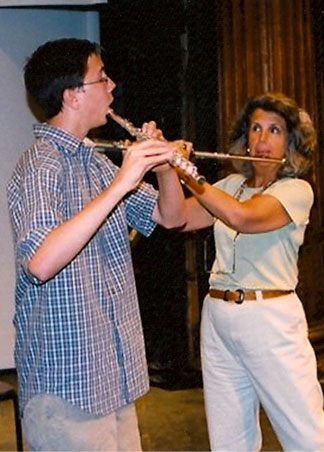Orchestral Etiquette
By Martha Aarons
Flute Talk—April 1998
As a member of the Cleveland Orchestra for 16 years I have been fortunate to work in flute sections here and elsewhere with conscientious, considerate colleagues who became my friends. However, over the years I have heard about flute sections that were not as amicable. Since a knowledge of protocol can help prevent the resentments that drive colleagues apart, I hope the following rules will serve as a useful guide.
Here are some suggestions and guidelines of some experienced orchestral flutists. Several of the most important “rules of decorum” are addressed by Jeanne Baxtresser in her Orchestral Excerpts book. She starts with:
- “Never practice someone else’s solo if you can be heard by anybody – this is considered bad form in any ensemble.” My own suggestion is even when preparing for an audition, please practice the excerpts out of hearing range of the section.
Baxtresser continues:
- “Don’t look around when someone else plays solo because this distracts the player if heads swivel around to stare as he negotiates a difficult passage. Never grimace or frown in reaction to something anyone has done. This is not as easy as it sounds because people are often unaware of their facial expressions. Every movement onstage in rehearsal or concert is important.” I should also warn that it is terribly tempting to look at a chorus, film screen, or some interesting activity behind the orchestra, but curtail the impulse during performances.
Regarding showing appreciation, Baxtresser suggests:
- ”If you have a genuine appreciation for the playing of others, don’t hesitate to tell them. We musicians, out of necessity, spend so much time thinking negatively about our playing, it is like a gift when a colleague expresses a sincere compliment. Be generous with support of your colleagues.” A little foot-shuffling in rehearsal for a well-played passage and more discreet signs of appreciation during concerts, such as tapping your thigh with silent applause, are traditional. As a colleague bows, join the applause as a courtesy.
Here are some other guidelines for orchestral musicians:
- Do not fuss conspicuously while someone plays an exposed or tricky passage. Choose another time to swab an instrument or turn a page; always so discreetly.
- Bail out colleagues in distress. If someone has lost count, rescue him. In the event of a mechanical failure, the player who least needs his instrument should hand it up. If the soloist breaks a string, the concertmaster exchanges violins with the soloist. Likewise, for example, if the principal flute player has a sudden pad leak, the third flute player, who is probably playing piccolo anyway, should hand up his flute.
- In rehearsal, stop when the conductor stops. Some players seem to enjoy having the last word, but this is an annoying and time-wasting habit.
- Don’t engage in unnecessary conversation with the conductor. Unless a question requires an immediate answer, put it off until the break. It is more professional to ask questions that apply only to you away from rehearsal. In my orchestra there is an unofficial clause requiring violators of this rule to bring donuts for the entire orchestra the following day.
- Do not act defensively when the conductor requests something of you. The strongest response is to simply nod your head to indicate understanding and a willingness to comply. Comments, arguments, and especially excuses make you seem insecure. Of course, some situations call for clarification or discussion, but this is best postponed until a break or after the rehearsal.
- Try to be as tactful ass possible in making a suggestion to a colleague. Saying, “Could we try…?” or “Let’s…” are obviously more endearing than accusations, commands, and sarcasm. In matters on intonation and style, be willing to compromise if the disparity is not extreme and the other party is battling an instrumental problem that he cannot surmount.
- Refrain from waving to friends or family from the stage at concerts, even if the program has not yet commenced. Waving looks unprofessional, especially if done conspicuously. If you are to meet someone at intermission, meet him offstage or in the public area.
I have some special advice for second flutists: Never overpower the principal with tone quality, dynamic, or vibrato. You should generally be an equal partner, but err on the side of discretion. When playing unisons, fit inside of the sound of the principal. Never insist on your pitch or rhythm when in your ensemble role, but do bring out your part when you have a solo, thematic material, or an interesting harmonic change. Finally, be willing to help the first flutist dovetail a long phrase or very long note, striving to match his sound.
Jeanne Baxtresser eloquently expresses the reason so many musicians dream of playing in an orchestra. “There are no words to describe the joys of playing the world’s greatest music in a great orchestra. One of the most powerful elements that makes this experience so overwhelming is that it is a shared experience. In the performing of beautiful music, you experience a relationship not only with the composer’s creation, but also with your fellow musicians with whom you share one of the closest relationships in a lifetime.”
Martha Aarons has been a member of the Cleveland Orchestra since 1981 and was formerly principal flutist of the North Carolina Symphony. A graduate of the Cleveland Institute of Music, Aarons is now on its faculty. Her teachers include William Hebert, Maurice Sharp, Julius Baker, Marcel Moyse, and George Drexler. She is also principal flute in the Aspen Chamber Symphony and teaches flute at the Aspen Festival.


